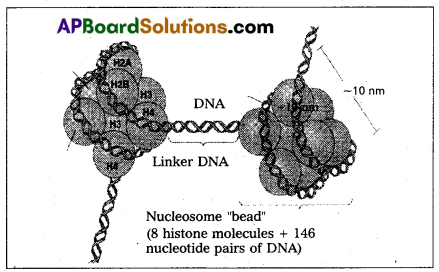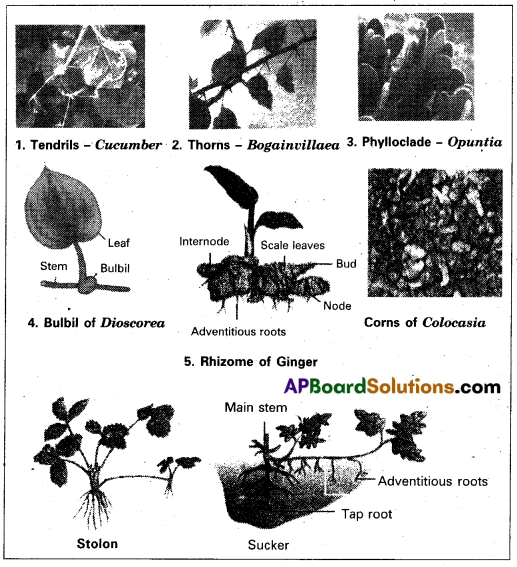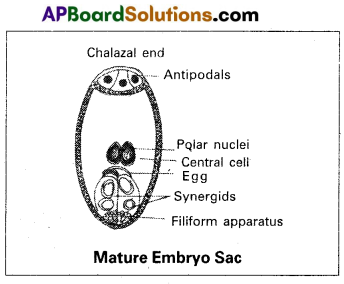Successful navigation through AP Inter 1st Year Botany Model Papers and AP Inter 1st Year Botany Question Paper March 2019 builds students’ confidence in their exam-taking abilities.
AP Inter 1st Year Botany Question Paper March 2019
Time: 3 Hours
Maximum Marks: 60
General Instructions:
Note : Read the following instructions carefully.
- Answer all the questions of Section – A. Answer any six questions out of eight in Section – B and answer any two questions out of three in Section – C.
- In Section – A, questions from Sr. Nos. 1 to 10 are of “Very Short Answer Type”. Each question carries two marks. Every answer may be limited to 5 lines. Answer all these questions at one place in the same order.
- In Section – B, questions from Sr. Nos. 11 to 18 are of “Short Answer Type”. Each question carries four marks. Every answer may be limited to 20 lines.
- In Section – C, questions from Sr. Nos. 19 to 21 are of “Long, answer Type”. Each question carries eight marks. Every answer may be limited to 60 lines.
- Draw labelled diagrams, wherever necessary for questions in Section – B and C.
Section – A (10 × 2 = 20)
Note : Answer all questions. Each answer may be limited to 5 lines.
Question 1.
What does ICBN stand for ?
Answer:
ICBN stands for International Code for Botanical Nomenclature.
Question 2.
What is the principle underlying the use of cyanobacteria in agricultural fields for crop improvement ?
Answer:
- Cyanobacteria can fix atmospheric Nitrogen in specialised cells called Heterocysts.
- It increased soil fertility.
Question 3.
Explain how the term Botany has emerged.
Answer:
In ancient Greek language, BOUSKEIN means cattle feed. The term Bouskein gave rise to Botane from which the term, Botany has emerged.
![]()
Question 4.
Which organ is modified to trap insects in insectivorous , plants ? Give two examples.
Answer:
Leaf Lamina is modified to trap insects in insectivorous plants. E.g. : Nepenthes, Drosera, Dionaea.
Question 5.
Why certain fruits are called false fruits ? Name two examples ‘ of plants having false fruits.
Answer:
Fruits which are formed from any other parts of the flower other” than the ovary are called false fruits. E.g. : Apple – Thalamus, Cashewnut – Pedical develops into false fruits.
Question 6.
What is “Omega Taxonomy” ?
Answer:
Taxonomy based on information from other branches like embryology, cytology, Palynology, Phytochemistry, Serology etc., in addition to morphological characters is called omega taxonomy.
Question 7.
Match the following :
a) Cristae – i) Flat membranous sacs in stroma
b) Cisternae – ii) Infoldings in mitochondria
c) Thylakoids – iii) Disc-shaped sacs in Golgi
Answer:
a) Cristae – i) Infoldings in mitochondria
b) Cisternae – ii) Infoldings in mitochondria
c) Thylakoids – iii) Disc-shaped sacs in Golgi
Question 8.
What constituents of DNA are linked by glycosidic bond ?
Answer:
A glycosidic bond is formed between two carbon atoms of two adjacent monosaccharides (or) Nitrogen base is linked to sugar group laterally by Glycosidic bond.
Question 9.
Which of four chromatids of a bivalent at prophase – I of meiosis can involve in cross over ?
Answer:
Non-sister chromatids.
![]()
Question 10.
Define population and community.
Answer:
A group of similar individuals belonging to the same species found in an area is called population.
An assemblage of all the populations belonging to different species occuring in an area is caleld community.
Section – B (6 × 4 = 24)
Note : Answer any six questions. Each answer may be limited to 20 lines.
Question 11.
Give a brief account of Dinofiagellates.
Answer:
a) Dinofiagellates are mostly marine and photosynthetic. They appear yellow, green, brown, blue or red depending on the pigment in their cells.
b) The cell wall has stiff cellulose plates on the outer surface.
c) They have two flagella and produce spinning movements. So these protists are also called “Whirling whips”.
d) The nucleus has condensed chromosomes which are without histones, called mesokaryon.
e) Some dinoflagellates like Noctiluca show bioluminescence
f) Red dinoflagellates like Gonyaulax undergo rapid multiple cation and make the sea appear red (Red tides in Mediterranean sea).
g) Toxins produced by them may kill fishes.
Question 12.
Write a note on economic importance of Algae and Bryophytes.
Answer:
Economic importance of Algae :
- A half of the carbondioxide fixation is carried out by Algae through photosynthesis and increases the level of oxygen in the environment.
- Many sps. Of Porphyra, Laminaria and Sargassum are used as food.
- Some marine Brown algae and red algae produce large amounts of hydrocolloids like Algin and Carrageen.
- Agar – Agar, a commercial product obtained from Gelidium and Gracilaria is used to grow microbes and also in the. preparation of ice-creams and gellies.
- Iodine is extracted from Laminaria.
- Chlorella and Spirulina are used as food supplements ever, by space travelers.
Economic importance of Bryophytes :
- Some mosses provide food for herbaceous mammals, birds and other animals.
- Species of Sphagnum. A moss provide peat used as fuel and because of its capacity to hold water as packing material for trans-shipment of living material.
- Mosses along with lichens are the first organisms to colonise rocks.
- Mosses form dense mats on the soil, thus prevents soil erosion.
- They play a significant role in plant succession.
Question 13.
Give a brief account on the phases of the life cycle of an angiosperm plant.
Answer:
In the life cycle of an angiospermic plant, two phases occur alternately.
They are :
A) Sporophytic phase : It is diploid (2n) and dominant phase of the life cycle. It is developed from the zygote. It produce Reproductive organs.
B) Gametophytic phase : It is haploid (n). It develops from the spore, which is a product of meiotic division of spore mother cell. In angiosperms, microspore mother cells and megaspore mother cells are present in anther and ovule respectively.
Each of these cells in turn gives microspores and megaspores after meiotic division. They develop into male and female gametophytes respectively. The male gametophyte gives male gamete and the female gametophyte forms the egg. Male and female gametes fuse to form a diploid zygote which develops into embryo in the seed. When the seed germinates, the embryo develops into sporophytic plant.
![]()
Question 14.
Write a brief note on semi-technical description of a typical flowering plant.
Answer:
1) The description of a flowering plant begins with its habit, habitat (Hydrophytes, Mesophytes or Xerophytes), vegetative
characters (Root, stem and leaves) and then floral characters (Inflorescence, Flower and its parts) and fruit.
2) After this, a floral diagram and a floral formula are presented. In floral formula Br or Ebr, Brl or Ebrl, actinomorphic 0r zygomorphic, Bisexual or unisexual, k – number of sepals, poly organosephalous, Aestivation, C – number of petals, poly or gamopetalous, Aestivation, A – number of stamens, free or united, G – number of carpels, free or fused, syn or Apocarpous, superior or inferior or any are mentioned. In floral diagram – K, C, A and G are mentioned in successive whorls.
Quetsion 15.
What are nucleosomes ? What are they madeup of ?
Answer:
Chromatin appears as beads of string’. These beads are known as nucleosomes. Atypical nucleosome contains 200 bp of DNA double helix wrapped around a core of histone octamer having two copies of each of four types of histone proteins i.e., H2A, H2B, H3 and H4, H1 histone lies outside the nucleosome core and seals the two turns of DNA by binding at the point where DNA enters and leaves the core, The DNA continues between two nucleosomes is called Linker DNA.

Question 16.
Though redundantly described as a resting phase, interphase does not really involve rest. Comment.
Answer:
The interphase also called phase of non apparent division though called the resting phase. It is the time during which the cell is preparing ‘ for division by undergoing cell growth and DNA replication. The interphase is divided into three further phases. They are a. G1 phase, S-phase and G2 phase.

a) G1 Phase :
It corresponds to the interval between mitosis and initiation of DNA replication. In this, the cell is metabolically active and grows continuously, RNA and Proteinsynthesis starts.
b) S-Phase : DNA replication takes place. The amount of DNA per cell doubles.
c) G2 Phase : Proteinsynthesis continues. Cell organelles increases in number. ATP synthesis necessary for spindle movement also starts in this phase.
Question 17.
What is the difference between lenticels and stomata ?
Answer:
| Lenticels | Stomata |
| 1. Lens shaped openings in the cork of woody stems. | 1. Openings present in the epidermis of the leaf. |
| 2. They contain closely arranged parenchymatous cells. | 2. Stomata is surrounded by specialised Guard cells. |
| 3. They permit the exchange of gases between the outer atmosphere and the inner tissues of the woody organs. | 3. They perform transpiration and exchange of gases. |
| 4. They are always open. | 4. Opening and closing mechanism is present. |
![]()
Question 18.
Enumerate the morphological adaptations of Xerophytes.
Answer:
- Roots are long with extensive branching spreading over wide areas.
- Root hairs and root caps are well developed.
- Mostly stems are stunted, woody, hard and covered with thick bark.
- Stems are usually covered by hairs or waxy coatings.
- Leaves are very much reduced to small, scale like and sometimes modified into spines to reduce the rate of transpiration.
- Lamina may be long, narrow, needle like or divided into many leaflets as in Acacia.
Section – C (2 × 8 = 16)
Note : Answer any two questions. Each answer may be limited to 60 lines.
Question 19.
Explain how stem is modified variously to perform different functions.
Answer:
Stems are modified in several ways to perform different functions.
They are :
1) Tendrils : Slender, spirally coiled structures which may develop either from auxiliary bud (cucumber) or from terminal bud (grapes) are called tendrils. They help in climbing.
2) Thorns : Buds are modified into woody, straight pointed
thorns which protect plants from grazing animals.
Ex : Citrus, Bougain villaea.
3) Phylloclade : In some plants of acid zones, leaves are modified into scales or spines to reduce the rate of transpiration. In such plants, stems are modified into flattened, green structure which carryout photosynthesis. Such stems are called phylloclades.
Ex : In euphorbia stem is cylindrical, in casuarina needle like, and in opuntia – flattened, fleshy green.
4) Bulbils : In some plants, the vegetative buds or floral buds store food materials. At maturity, may detach from the parent plants, develop adventitious roots, grow as new plants thus help in vegetative reproduction.
Ex : Diascoria.
5) Underground stems : In some plants, stem grows into soil, Store food materials, show perennation, to resist unfavourable condi¬’ tions and also help in vegetative reproduction. Such stems are called underground stems.
Ex : Rhizome – Ginger, com – colacacia.
6) Sub aerial stems : In some plants, some part of the stem is underground and some part is aerial. Such stems are called sub aerial stems. In such plants, slender, lateral branches arises from the base of the main axis, grow vertically, arches downwards, produce adventitious roots when touches the ground. When they separates from the parent plant, they develop into new plants they help in vegetative reproduction.
Ex : Stolons – Nerium, Jasmine
Suckers – Chrysanthemum, Mertha.

Question 20.
With a neat, labelled diagram, describe the parts of a mature angiosperm embryo sac. Mention the role of synergids.
Answer:
Mature angiosperm embryosac shows three parts.
They are :
1) Egg apparatus
2) Antipodals
3) Central cell.

- Egg Apparatus : Three cells present towards the micropyle of the embryosac together called egg apparatus. Of which, the central, largest one is called egg and two lateral cells are called synergids. Synergids show finger like projections towards the micropyle called filliform apparatus.
- Antipodals : Three cells present towards the chalazal end of the ovule are called antipodals. They are also referred to as vegetative ’ells of the embryosac and disintegrates before or after fertilisation.
- Central cell : It is the largest cell of the embryosac. It is formed by the fusion of two polar nuclei. It is also called secondary nucleus. It shows central vacuole and 2 haploid polamuclei.
Role of synergies :
- The filliform apparatus of the synergids absorbs food materials from the Nu cells and supplies to embryosac.
- It also secretes some chemicals which direct the growth of the pollen tube towards embryosac.
![]()
Question 21.
Describe the internal structure of dorsi-ventral leaf with the help of labelled diagram.
Answer:
Transverse section of a dorsiventral leaf (dicot leaf) shows 3 important parts.
They are :
1. Epidermis
2. Mesophyll and
3. Vascular bundles.
1. Epidermis : Epidermis is present on the both the upper surface (upper epidermis) (adaxial) and the lower surface (abaxial) ‘ of the leaf. The. epidermis is made up of one row of barrel shaped cells, which are arranged compactly without intercellular spaces. The cells are filled with vacuolated and nucleated protoplast. On outerside of the epidermis a waxy layer called Cuticle is present. Stomata are present, more on the lower surface than on the upper surface. Each stoma is surrounded by two kidney shaped guard cells. They are chlorophyllous and regulate the opening and closing of stomata. Epidermis shows multicellular uniseriate hairs. The cells of leaf hairs are filled with water. They protect the inner tissues by absorbing the – heat and prevents evaporation of water from the leaf surface. The stomata help in the gaseous exchange and also promote transpiration.
2. Mesophyll : The ground tissue that extends between the upper and lower epidermal layers is called the mesophyll. It is composed of thin walled parenchyma with chloroplasts. It is chiefly concerned with the synthesis of carbohydrates. In dicot leaves mesophyll is differentiated into two parts namely :
i) Palisade parenchyma and
ii) Spongy parenchyma.
i) Palisade parenchyma : Part of the mesophyll found beneath the upper epidermis is called ‘palisade tissue’. It shows elongated, columnar cells arranged in 1 – 3 vertical rows. Narrow intercellular spaces are present between the cells. In these cells, large numbers of chloroplasts ‘ are found nearer to the cell wall. Palisade tissue is primarily concerned with the manufacture of carbohydrates in the presence of sunlight.
ii) Spongy parenchyma : Part of the mesophyll found towards . the lower epidermis is called spongy tissue. It shows 3-5 rows of irregular shaped cells that are arranged loosely with large intercellular spaces. Some intercellular spaces present in the vicinity of the stomata are very large, forming air chambers (air cavities). In these cells, number of chloroplasts is less. That is why the upper surface of leaf is dark green and the lower surface is light green in colour. Spongy tissue has a primary role in gaseous exchange, apart from the synthesis of food materials.
3. Vascular bundles : Vascular bundles are extended in the mesophyll in the form of veins. They help in supplying water, mineral salts and food materials all over the leaf surface. Veins also provide mechanical strength to the leaf.

The vascular bundles are conjoint, collateral and closed. The xylem is present on the upper side and phloem on the lower side. Cambium is absent between them. Xylem shows vessles, tracheids, parenchyma and fibres. Phloem shows sieve tubeis companion cells and phloem parenchyma.
Each vascular bundle is surrounded by a layer of specialised mesophyll cells that are arranged closely and compactly without intercellular spaces. This layer is called bundle sheath or border parenchyma. The bundle sheath cells divide and grow towards the upper and lower epidermal layers. These are called bundle sheath extensions. They help in the conduction of food materials form the mesophyll to the vascular bundles.